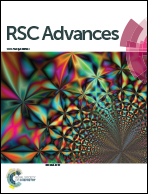Thermo-responsive poly(ethylene-co-vinyl alcohol) based asymmetric membranes
Abstract
This paper reports surface modification of hydrophilic poly(ethylene-co-vinyl alcohol) (EVAL) microporous membranes, by surface-initiated atom transfer radical polymerization (SI-ATRP) of N-isopropylacrylamide (NIPAAm) and its subsequent applications in thermo responsive permeation. The surface thermo responsive behaviour of the membrane was characterized by water contact angle and bovine serum albumin (BSA) adsorption measurements at different temperatures. It was found that the hydrophilicity of the membrane is improved and the BSA adsorption was significantly suppressed by the poly N-isopropylacrylamide (pNIPAAm) NIPAAm grafting. Below the lower critical solution temperature (LCST) of pNIPAAm, a smaller amount of protein was adsorbed on the membranes, and a diametrically opposite effect with larger amounts of protein adsorption was evident above the LCST. The water flux and protein rejection at different temperatures were also determined for modified and unmodified membranes. The permeation results showed an obvious increase in the water flux in the temperature range 31–34 °C for the modified membranes due to the LCST of pNIPAAm. Protein rejection is found to be switched when the temperature is changed through the LCST of grafted pNIPAAm. Thermo responsive release of vitamin B12 has been also confirmed. These results indicate that the pore size of the membrane can be regulated in response to the temperature.


 Please wait while we load your content...
Please wait while we load your content...